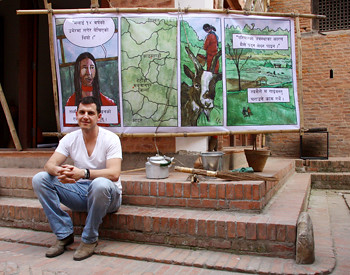For the past year and a half, graphic journalist and Fulbright fellow Dan Archer travelled to Bhaktapur, Kavre, Makwanpur, Dang, and Mahendranagar gathering testimonies from trafficking survivors. He adapted these stories into comics and the exhibition will open this week at Image Ark Gallery. Nepali Times caught up with Archer just as he was getting ready for the opening of his exhibit.

CINDREY LIU
Dan Archer: When I first arrived here in October 2012, I gave a short presentation during one of the Pecha Kucha nights. After the presentation, Ingrid Chiron of Image Ark Gallery approached me and suggested that I use my art for social justice. But I didn’t want to be the person who parachutes in, takes pictures of poor desperate people, and then returns to his comfort zone. I wanted to listen to firsthand stories, instead of taking clichéd snapshots.
I had worked on human trafficking between Russia and Ukraine earlier, so I have some understanding of the topic. My work in Nepal is also part of a larger research project at Stanford and Vanderbilt universities which aims to assess the impact of visual awareness-raising materials.
Why comics?
What I really like about comics is that they’re very malleable. They appeal to a large demographic and are a better medium to engage younger, harder to reach audiences like children. When I take sketches, I can involve the subjects in some sort of dialogue. I feel comics are a real grassroots media: you don’t have to depend on a projector or electricity, they are just there for everyone to see.
How challenging was it to gather stories from victims of trafficking?
I prefer to use the term survivor because it’s hard enough for the women and I certainly want to get away from the victim stereotype. I feel that there’s this myth being built around in NGO circles and at times I’ve been guilty of doing the same. One of the stories I cover is called The White Knight, where I try to deconstruct the image of the white westerner who comes in and saves the day. I want the viewers to understand that the women have become stronger and reintegrated into society after overcoming immense suffering.
How did you approach the protagonists of your story?
I met the protaganists through NGOs and at workshops. But I wasn’t interested in the trauma like other journalists. Instead I wanted to focus on how the traffickers managed to appropriate the women and the position they found themselves in. I think this approach gave the survivors some comfort.
What was the hardest aspect about the project?
Anything of sexual nature is naturally very tough to explore, especially for those who’ve been through child abuse. Sometimes just seeing them is hard enough. One of the survivors I talked to, Bimala, is just nine-years-old and now she’s working in a brick kiln. To see them like that and then to leave them, that was the most difficult part.
Have you met the protagonists of your stories since you last saw them?
It’s hard to visit people in the far-west for logistical reasons. I’ve been to Bhaktapur several times to meet Bimala, I also saw the circus performance several times.
How else have you kept yourself busy?
I teach English and art at Change Nepal in Thamel. Before I leave the country, I want to train as many students as I can, mostly children so that they can tell their own stories. My goal is to give words to people who otherwise wouldn’t have the means to express themselves, just like the women in my stories.
Graphic voices from Nepal: An investigation of human trafficking
16 April to 14 May, 10am to 5pm except on Saturdays
Image Ark Gallery, Kulimha Tol, Patan, (01)5006665, 9851016572
www.graphicvoices.com
www.archcomix.com
www.image-ark.com